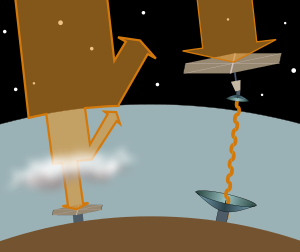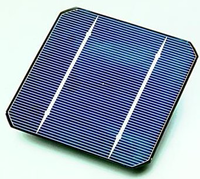الطاقة الشمسية الفضائية
الطاقة الشمسية الفضائية (SBSP) (أو تاريخيا الطاقة الشمسية من الفضاء (SSP )) هو نظام لجمع الطاقة الشمسية في الفضاء ، لاستخدامها في الأرض. SBSP يختلف عن الأسلوب المعتاد لجمع الطاقة الشمسية في أن الألواح الشمسية المستخدمة لجمع الطاقة من شأنها أن تقام في الأقمار الصناعية في المدار ، وغالبا ما يشار إليه على أنه 'الطاقة الشمسية من الأقمار الصناعية '(SPS) ، بدلا من التركيز على سطح الأرض. في الفضاء ، وجمع الطاقة من الشمس لا يتأثر بدورة النهار / الليل ودورة الطقس والفصول ، أو تأثير الفلترة لتصفية غازات الغلاف الجوي للأرض.
أعتمد هذاالمشروع ، على أن تضطلع به مجموعة أبحاث من 16 شركة من بينها شركة ميتسوبيشي للصناعات الثقيلة المحدودة ، ويهدف إلى إنفاق السنوات الأربع المقبلة في تطوير التكنولوجيا اللازمة لتوجيه شعاع من الكهرباء المنتجة إلى الأرض. كما انهم يتوقعون ان نفاذ الوقود الحفري ، ربما يكون حافزا لأن تكون هناك حاجةلتطوير محطة مدارية للطاقة الشمسية و جعلها تدور حول الأرض في الفضاء لتوفير مصدر هام من مصادر الكهرباء في المستقبل، هذا وفقا لكانيكي يو كينسوكى ، من الحكومة اليابانية من معهد اقتصاديات الطاقة.

محطة الطاقة الشمسيةالمزمعة سوف تنتج 1 جيجوات من الكهرباء من مصفوفتها الشمسية التى تتكون من مساحةأربعة كيلومترات (حوالي 2.5 ميل مربع) من الألواح الشمسية ، وهو ما يكفي لمجرد توفير الطاقة اللازمة لإستخدام 300،000 منزلا بطوكيو ، في مستويات الاستخدام الحالية. و تلك المصفوفة ستكون في مدار يبعد نحو 36،000كم (حوالى 22،500 ميلا مربعا فوق سطح الأرض) ، فإنها لا تتأثر الأحوال الجوية ، وسوف تكون قادرة على توليد الطاقة باستمرار.
وكالة ناسا الامريكية قد تم التحقيق في احتمالات وجود نظام فضائي شمسي على مدى عدة عقود وانفقت نحو 80 مليون دولار على البحوث. وكانت وكالات حكومية أخرى قد قدرت تكلفة الكهرباء المقدمة من المجموعة الشمسية التي تدور حول يمكن أن حوالي 1 مليار دولار لكل ميغاواط ، وهي مكلفة للغاية لتكون مجدية تجاريا.
أدرك اليابانيون أن تكلفة بناء محطة للطاقة الشمسية في المدار ستكون باهظة في هذه اللحظة ، وتلك المصفوفة الشمسية لا يمكن ان تكون مجدية تجاريا بأسعار اليوم. الكونسورتيوم الياباني كان عليه إيجاد سبل لخفض ملموس للتكاليف. فإن إطلاق صاروخ واحد تقدر تكاليفه بنحو 10 مليار ين ، و تكلفة المحطة الفضائية الشمسية يمكن ان تكون مرتفعة و تتجاوز اثنين تريليون ين ، وفقا لكوجي أوميهارا ، مدير وزارة التنمية والتطوير الفضائية اليابانية ، مما يجعل من الكهرباء التي تزودها المحطة باهظة للغاية الخطوة الأولى في تقديم خطط لتؤتي ثمارها ، هى إطلاق الأقمار الصناعية المزودة بالألواح الشمسية التي سوف تطلق شعاع الكهرباء إلى الأرض في حوالي 2015.
جاكسا وكالة استكشاف الفضاء اليابانية تخطط لوضع المحطة المدارية الشمسيةالتي تدور حول الأرض قيد التشغيل في وقت ما من عام 2030.
تكلفة الإطلاق
One problem for the SBSP concept is the cost of space launches and the amount of material that would need to be launched.
Much of the material launched need not be delivered to its eventual orbit immediately, which raises the possibility that high efficiency (but slower) engines could move SPS material from LEO to GEO at an acceptable cost. Examples include ion thrusters or nuclear propulsion.
To give an idea of the scale of the problem, assuming a solar panel mass of 20 kg per kilowatt (without considering the mass of the supporting structure, antenna, or any significant mass reduction of any focusing mirrors) a 4 GW power station would weigh about 80,000 metric tons,[1] all of which would, in current circumstances, be launched from the Earth. This is, however, far from the state of the art for flown spacecraft, which as of 2015 was 150W/kg (6.7 kg/kW), and improving rapidly.[2] Very lightweight designs could likely achieve 1 kg/kW,[3] meaning 4,000 metric tons for the solar panels for the same 4 GW capacity station. Beyond the mass of the panels, overhead (including boosting to the desired orbit and stationkeeping) must be added.
| 1 kg/kW | 5 kg/kW | 20 kg/kW | |
|---|---|---|---|
| $1/kg (Minimum cost at ~$0.13/kWh power, 100% efficiency) | 4 مليون $ | 20 مليون $ | 80 مليون $ |
| 2000 $/كج (مثل: فالكون ثقيل) | $8B | $40B | $160B |
| $10000/kg (ex: Ariane V) | $40B | $200B | $800B |
To these costs must be added the environmental impact of heavy space launch missions, if such costs are to be used in comparison to earth-based energy production. For comparison, the direct cost of a new coal[4] or nuclear power plant ranges from $3 billion to $6 billion per GW (not including the full cost to the environment from CO2 emissions or storage of spent nuclear fuel, respectively).
البناء من الفضاء
من مواد قمرية مُطلقة في مدار
على القمر
من كويكب
معرض صور
الخط الزمنى
- 1968: الدكتور پيتر گلاسر يدخل مفهوم الطاقة الشمسية الكبيرة للأقمار الصناعية نظام الأميال المربعة من تجميع الطاقة الشمسية في [عالية المدار المتزامن مع الأرض (جيو هو مدار 36،000 كيلومتر فوق خط الاستواء) ، لجمع وتحويل من طاقة الشمس إلى شعاع الموجات الكهرومغناطيسية لنقل الطاقة يمكن استخدامها لهوائيات استقبال كبيرة (rectennas) على الأرض من أجل توزيعها على شبكة الطاقة الكهربائية الوطنية..
- 1973: الدكتور بيتر غلاسر منح براءة الاختراع الامريكية رقم 81.647 لهذه الطريقة لنقل الطاقة لمسافات طويلة (على سبيل المثال ، من SPS إلى سطح الأرض ) باستخدام [[الميكروويف] من مسافات كبيرة جدا (تصل إلى كم مربع ) هوائي على القمر الصناعي إلى هوائى أكبر بكثير على الأرض ,التي تعرف الآن باسم وريكتينا. .[5]
- '1970 ' : وزارة الطاقة و ناسا بفحص الطاقة الشمسية الفضائية (SPS),والمفهوم واسع
- ' '1994' : إن الولايات المتحدة سلاح الجو يجري تجارب الطاقة الشمسية المتقدمة باستخدام الأقمار الصناعية التي تطلق في مدار منخفض حول الارض من قبل صاروخ بيغاسوس.
- «'1995 - 1997 : وكالة ناسا تجري "نظرة جديدة" دراسة الفضاء الطاقة الشمسية (SSP) المفاهيم والتكنولوجيات.
- 1998: الفضاء لتوليد الطاقة الشمسية دراسة تعريف مفهوم (CDS) ويحدد مدى الجدوى التجارية ,المفاهيم ل SSP التي هي ذات مصداقية ، مع وجود مخاطر التقنية والبرنامجية التي تم تحديدها.
- 1999: ناسا برنامج الطاقة الشمسية في الفضاء الاستكشافية للبحث والتكنولوجيا (SERT انظر أدناه) .
- 2000: جون مانكنز من وكالة ناسا يشهد في مجلس النواب الأمريكي أن " SSP على نطاق واسع هو نظام معقد جدامن النظم المتكاملة التي تتطلب العديد من التقدم الكبير في مجال التكنولوجيا والقدرات الحالية. وخارطة الطريق والتكنولوجيا التى قد تم تطويرها والتي تحدد المسارات المحتملة لتحقيق كل حاجة السلف التطورات — وإن كان ذلك على مدى عدة عقود.[6]
- 2001: مؤسسة باورسات التى أسسها ويليام مانيس.
- ' '2001' : الدكتور نيفيل Marzwell من وكالة ناسا "لدينا الآن تكنولوجيا لتحويل طاقة الشمس بمعدل 42 الى 56 في المئة... لقد حققنا تقدما هائلا.... إذا كنت تستطيع تركز أشعة الشمس من خلال استخدام المرايا الكبيرة أو عدسات لتحصل على مزيد من الطاقة تبرر مزيد من النفقات ، لأن معظم التكلفة هى في صفائف الفلطاضوئية.(PV arrays).. هناك عنصر المخاطرة ولكن يمكنك الحد من ذلك... يمكنك وضع هذه المستقبلات الصغيرة في الصحراء أو في الجبال بعيدا عن المناطق المأهولة بالسكان. ...نحن نعتقد أنه في خلال 15-20 سنة, يمكننا خفض تلك التكلفة إلى 7% أو 10 %5 لكل كيلووات/ساعة , ونحن نحصل على ميزة, فأنت لاتحتاج إلى كابلات, أو أنابيب أو غاز أو أسلاك نحاسية, نحن نستطيع إرسالها إليك, مثل مكالمات موجات الهاتف الخلوى.حيثما تريدها ووقت ما تشاء, في الوقت الحقيقى ...."[7]
- 2001 : ناسدا ( وكالة الفضاء الوطنيةاليابانية) أعلنت عن خطط لإجراء المزيد من البحوث والنماذج من خلال إطلاق قمر اصطناعي تجريبي للقدرة التى تتراوح بين 10 كيلووات و1 ميغاواط من الطاقة.[8][9]
- ' '2007' : وزارة الدفاع الوطني في مكتب أمن الفضاء (NSSO) أصدرت تقريرا[10] في 10 تشرين الاول 2007 ، من ان الدول التي تنوي جمع الطاقة الشمسية من الفضاء لاستخدامها على الأرض لمساعدة الولايات المتحدة تنمية علاقة مستمرة مع الشرق الاوسط و لأجل المعركة من اجل النفط.فأن محطة الفضاء الدولية هى الأكثر احتمالا أن تكون أول اختبار على الأرض لهذه الفكرة الجديدة ، حتى ولو كانت في مدار منخفض حول الأرض.
- ' '2007' : وفي أيار / مايو 2007 ورشة عمل عقدت في MIT لاستعراض الحالة الراهنة للسوق والتكنولوجيا.[11]
- 2009 : الشركة الجديدة مؤسسةطاقة الفضاء وضعت خططا لتوفير الطاقة الشمسية المستندة من الفضاء تجاريا. ويقولون انهم طوروا "- منصة صلبة للأعمال " التى ينبغي أن تكون قادرة على توفير الطاقة الشمسية المستندة من الفضاء في غضون عقد.[12]
- 2009: المحيط الهادئ للغاز والكهرباء (PG&E) تعلن انها تسعى للحصول على الموافقة التنظيمية من أجل التوصل إلى اتفاق مع Solaren لشراء 200 ميجاوات من الطاقة الشمسية ، بداية من عام 2016 ، و التى تخطط Solaren لتوفيرها عبر SBSP ) جوناثان مارشال المتحدث باسم (PG&E ذكر أنه "لقد كنا حذرين جدا لتحمل المخاطرة في هذا الأمر."[13][14][15]
- ' '2009' :مؤسسة PowerSat تسعى للحصول على براءة اختراع تتعلق بتكتل للأقمار بقوة متعددة لتشكيل وحدة متماسكة من حزم الميكروويف ، ووضع آلية لاستخدام الطاقة الشمسية لمجموعة ion thrusterلرفع الطاقة من الأقمار الصناعية المدارية من LEO إلى .[16]
- 2010: Professors Andrea Massa and Giorgio Franceschetti announce a special session on the "Analysis of Electromagnetic Wireless Systems for Solar Power Transmission" at the 2010 Institute of Electrical and Electronics Engineers International Symposium on Antennas and Propagation.[17]
- 2010: The Indian Space Research Organisation and US' National Space Society launched a joint forum to enhance partnership in harnessing solar energy through space-based solar collectors. Called the Kalam-NSS Initiative after the former Indian President Dr APJ Abdul Kalam, the forum will lay the groundwork for the space-based solar power program which could see other countries joining in as well.[18]
- 2010: Sky's No Limit: Space-Based solar power, the next major step in the Indo-US strategic partnership?] written by USAF Lt Col Peter Garretson was published at the Institute for Defence Studies and Analysis.[19]
- 2012: China proposed joint development between India and China towards developing a solar power satellite, during a visit by former Indian President Dr APJ Abdul Kalam.[20]
- 2015: The Space Solar Power Initiative (SSPI) is established between Caltech and Northrop Grumman Corporation. An estimated $17.5 million is to be provided over a three-year project for development of a space-based solar power system.
- 2015: JAXA announced on 12 March 2015 that they wirelessly beamed 1.8 kilowatts 50 meters to a small receiver by converting electricity to microwaves and then back to electricity.[21][22]
- 2016: Lt Gen. Zhang Yulin, deputy chief of the [PLA] armament development department of the Central Military Commission, suggested that China would next begin to exploit Earth-Moon space for industrial development. The goal would be the construction of space-based solar power satellites that would beam energy back to Earth.[23][24]
- 2016: A team with membership from the Naval Research Laboratory (NRL), Defense Advanced Projects Agency (DARPA), Air Force Air University, Joint Staff Logistics (J-4), Department of State, Makins Aerospace and Northrop Grumman won the Secretary of Defense (SECDEF) / Secretary of State (SECSTATE) / USAID Director's agency-wide D3 (Diplomacy, Development, Defense) Innovation Challenge with a proposal that the US must lead in space solar power. The proposal was followed by a vision video
- 2016: Citizens for Space-Based Solar Power has transformed the D3 proposal into active petitions on the White House Website "America Must Lead the Transition to Space-Based Energy"and Change.org "USA Must Lead the Transition to Space-Based Energy" along with the following video.
- 2016: Erik Larson and others from NOAA produce a paper "Global atmospheric response to emissions from a proposed reusable space launch system"[25] The paper makes a case that up to 2 TW/year of power satellites could be constructed without intolerable damage to the atmosphere. Before this paper there was concern that the NOx produced by reentry would destroy too much ozone.
- 2016: Ian Cash of SICA Design proposes CASSIOPeiA (Constant Aperture, Solid State, Integrated, Orbital Phased Array) a new concept SPS [1]
- 2017: NASA selects five new research proposals focused on investments in space. The Colorado School of Mines focuses on "21st Century Trends in Space-Based Solar Power Generation and Storage."
- 2020: US Naval Research Laboratory launches test satellite.[26]
انظر أيضاً
مراجع
- ^ "Space-Based Solar Power". energy.gov.
- ^ "Solar Power and Energy Storage for Planetary Missions" (PDF). August 25, 2015.
- ^ "Case For Space Based Solar Power Development". August 2003. Retrieved 2006-03-14.
- ^ "2006_program_update" (PDF). Archived from the original (PDF) on 2007-01-10.
- ^ Glaser, Peter E. (December 25, 1973). "Method And Apparatus For Converting Solar Radiation To Electrical Power". United States Patent 3,781,647.
- ^ Statement of John C. Mankins U.S. House لجنة فرعية بشأن الفضاء والطيران لجنة علمية، 7 سبتمبر 2000
- ^ Beam it Down, Scotty! Mar, 2001 from Science@NASA
- ^ Report: Japan Developing Satellite That Would Beam Back Solar Power
- ^ Presentation of relevant technical background with diagrams: http://www.spacefuture.com/archive/conceptual_study_of_a_solar_power_satellite_sps_2000.shtml
- ^ National Security Space Office Interim Assessment Phase 0 Architecture Feasibility Study, October 10, 2007
- ^ Terrestrial Energy Generation Based on Space Solar Power: A Feasible Concept or Fantasy? Date: May 14–16, 2007; Location: MIT, Cambridge MA
- ^ http://science.slashdot.org/article.pl?sid=09/02/20/0149254
- ^ Sweet, Cassandra (April 13, 2009,). "UPDATE: PG&E Looks To Outer Space For Solar Power (broken link)". The Wall Street Journal. Retrieved 2009-04-14.
{{cite news}}: Check date values in:|date=(help)CS1 maint: extra punctuation (link) - ^ Marshall, Jonathan (April 13, 2009). "Space Solar Power: The Next Frontier?". Next 100. Pacific Gas and Electric (PG&E). Retrieved 2009-04-14.
- ^ "Utility to buy orbit-generated electricity from Solaren in 2016, at no risk". MSNBC. April 13, 2009. Retrieved 2009-04-15.
- ^ PowerSat patent press release
- ^ Special Session list, IEEE International Symposium on Antennas and Propagation, April 20, 2010, http://www.apsursi2010.org/?m=page&id=47
- ^ Mridul Chadha (November 10, 2010), US, India launch space based solar energy initiative, Archived from the original on July 31, 2012, https://web.archive.org/web/20120731010405/http://ecopolitology.org/2010/11/10/us-india-launch-space-based-solar-energy-initiative/
- ^ "Sky's No Limit: Space-based solar power, the next major step in the Indo-US strategic partnership? | Institute for Defence Studies and Analyses". www.idsa.in. Retrieved 2016-05-21.
- ^ PTI (November 2, 2012), US, China proposes space collaboration with India, http://articles.timesofindia.indiatimes.com/2012-11-02/india/34877401_1_space-solar-power-space-collaboration-v-ponraj
- ^ خطأ استشهاد: وسم
<ref>غير صحيح؛ لا نص تم توفيره للمراجع المسماةATarantola - ^ خطأ استشهاد: وسم
<ref>غير صحيح؛ لا نص تم توفيره للمراجع المسماةPKT - ^ "Exploiting earth-moon space: China's ambition after space station - Xinhua | English.news.cn". news.xinhuanet.com. Retrieved 2016-05-21.
- ^ 宋薇. "Exploiting earth-moon space: China's ambition after space station - China - Chinadaily.com.cn". www.chinadaily.com.cn. Retrieved 2016-05-21.
- ^ Larson, Erik J. L.; Portmann, Robert W.; Rosenlof, Karen H.; Fahey, David W.; Daniel, John S.; Ross, Martin N. (2017). "Global atmospheric response to emissions from a proposed reusable space launch system". Earth's Future. 5 (1): 37–48. Bibcode:2017EaFut...5...37L. doi:10.1002/2016EF000399.
مصادر
للاستزادة
وصلات خارجية
- Powering the Planet Watch a 20 minute online video from The Futures Channel that provides a "101" on space-based solar power
- The World Needs Energy from Space Space-based solar technology is the key to the world's energy and environmental future, writes Peter E. Glaser, a pioneer of the technology.
- Reinventing the Solar Power Satellite", NASA 2004-212743, report by Geoffrey A. Landis of NASA Glenn Research Center
- Japan's plans for a Solar Power Station in Space - the Japanese government hopes to assemble a space-based solar array by 2040.
- Whatever happened to solar power satellites? An article that covers the hurdles in the way of deploying a solar power satellite.
- Solar Power Satellite from Lunar and Asteroidal Materials Provides an overview of the technological and political developments needed to construct and utilize a multi-gigawatt power satellite. Also provides some perspective on the cost savings achieved by using extraterrestrial materials in the construction of the satellite.
- A renaissance for space solar power? by Jeff Foust, Monday, August 13, 2007 Reports on renewed institutional interest in SSP, and a lack of such interest in past decades.
- PowerSat Corporation / PowerSat Limited website Commercial space based solar power companies in Europe and the United States.
- "Conceptual Study of A Solar Power Satellite, SPS 2000" Makoto Nagatomo, Susumu Sasaki and Yoshihiro Naruo
- Researchers Beam 'Space' Solar Power in Hawaii (Wired Science)
- http://www.nss.org/settlement/ssp/library/index.htm — The National Space Society's Space Solar Power Library







